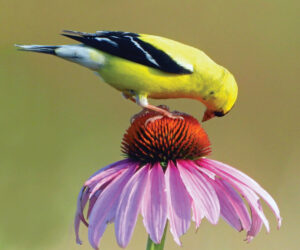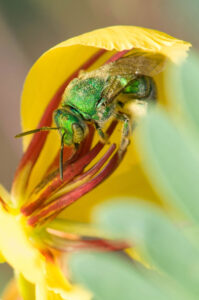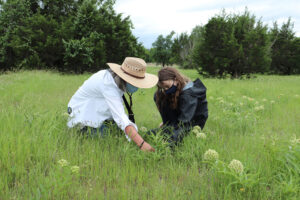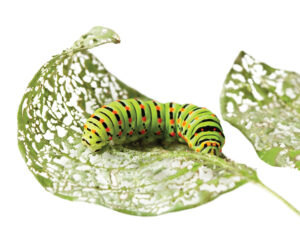Anyone who gardens, or even putters in the yard, knows the simple act of gardening provides many benefits – fresh air, exercise, stress relief and access to fresh foods to name a few. But they may not realize those simple acts can help save the world, especially the wild world.
By using sustainable wildlife-friendly practices, gardeners can have a significant positive impact on the planet and all its interconnected inhabitants, including humankind.

Entomologist and conservationist Doug Tallamy has been exploring and explaining those connections for more than three decades in his job as a University of Delaware professor and researcher. His work, which includes studying issues such as the impact of native versus nonnative plants on interconnected wildlife species (caterpillars and chickadees, for example), led Tallamy to write “Bringing Nature Home: How You Can Sustain Wildlife with Native Plants.”
This award-winning book focuses on the whys and hows of gardening for nature and, since its publication in 2007, has made Tallamy a guru in the growing movement toward more nature- and wildlife-friendly gardening. That movement has never been so important as it is today.
“We are in a global wildlife extinction crisis,” says David Mizejewski, spokesperson for the National Wildlife Federation’s Garden for Wildlife program and author of the how-to book “Attracting Birds, Butterflies and Other Backyard Wildlife.”
“More than a million wildlife species worldwide are endangered,” he says. “In the U.S. alone, some 12,000 animal species are experiencing rapid population declines and one-third of all native wildlife species are at an increased risk of extinction in the coming decade.”
Among these species are beloved yard and garden visitors such as birds and butterflies as well native bee species, which play essential roles in crop pollination. These statistics are disturbing not just because they represent the loss of irreplaceable wildlife populations but also their dilemma may be a harbinger for the future of humankind, which also relies on healthy ecosystems.
Humans are also connected to nature cognitively, says Michelle Bertelsen, an ecologist with the Lady Bird Johnson Wildlife Center in Texas. “We have evolved and learned to think by interacting with the natural world forever and ever and ever. That doesn’t stop just because we may live in cities.” It is a connection many humans have come to appreciate during the past two years of the global COVID-19 pandemic.
“People have sought solace in nature during these tough times,” Mizejewski says, and many found it in their own yards, especially at the peak of COVID-19 shutdowns and stay-at-home orders.
While concerns about and connections to nature are increasing, they are also a source of frustration. “Everybody on the planet requires healthy ecosystems,” Tallamy says. But, he adds, when faced with stark statistics about the decline of wildlife and ecosystems “most people feel absolutely powerless. The Earth is huge and what can one person do?”
A lot, agree Tallamy, Mizejewski and Bertelsen, and it all begins in the landscapes that surround us.

“How we choose to manage and care for our own piece of earth is a powerful way to help declining populations,” Mizejewski says. “What we do in our backyards is not going to save polar bears, but it can make a huge difference for the rapidly declining Monarch butterflies and the birds and wild bee species that need our help.”
“There is a central role that Joe Public can play because Joe Public owns the country,” Tallamy adds, explaining while public parks, preserves and wilderness areas provide vital habitat for wildlife, they alone cannot save these species. However, on the 78 percent of U.S. land that is privately owned, wildlife-friendly management can have huge impacts on these animals and the overall health of the planet.
That kind of impact can occur anywhere and on any piece of land, from large rural fields to medium-sized suburban yards to tiny urban greenspaces. According to Bertelsen, studies have shown that putting small strips of pollinator habitat between rows or on the edges of agricultural land can greatly benefit pollinators, which in turn benefits the crops. The same can happen in our yards.
“It’s amazing how much impact a small pollinator garden can have,” Bertelsen says. “Even tiny islands [of wildlife-friendly real estate] in cities can help these species out so much. A little bit does go a long way.” When many people in the same vicinity and eventually across the globe provide wildlife habitats, such as pollinator gardens, the impact grows exponentially.

So, what exactly is a wildlife-friendly landscape? According to Tallamy, it’s a landscape that contributes four components to the local ecosystem. It supports a diverse population of pollinators, supports the greater food web, sequesters carbon, and protects and manages watersheds. Many of these functions, says Mizejewski, can be accomplished by providing wildlife with four basic needs: food, cover, places to raise young and water.
“All wildlife, whether in the wilderness or in our gardens, need these things,” Mizejewski says. As they create a food web, they also create an ecosystem that supports all life in the area. “It’s a circle of life thing.”
It just so happens the primary foundation of any ecosystem is the very thing that makes a garden a garden – plants, but not just any plants.
“The most important thing [about gardening for nature and wildlife] is to pick the right plants,” Mizejewski says. “Those are going to be plants native to your region, plants that have co-evolved with wildlife and that wildlife needs to survive.”
Native plants can provide three of the four basic circle-of-life needs – food, shelter and nesting/birthing sites. Just add water, and you have a wildlife-friendly habitat.
Going wild doesn’t mean yards and gardens must look wild. “It’s a common misperception that a wildlife-friendly or natural garden equals a messy garden,” says Mizejewski. “You can have a beautiful, magazine photo-worthy garden space that is also extremely beneficial to wildlife. It’s a design choice and there is a continuum.”

That continuum ranges from a formal, manicured look to an informal natural look and everything in between, and it can be accomplished gradually over time. Taking one small step, such as replacing a portion of lawn with a small bed of wildflowers or a single oak tree, can make a huge difference. It can set an example for others to emulate.
Tallamy notes even folks living in high-rise apartments and concrete jungles without access to so much as a postage-stamp sized patch of land can help by donating to, or volunteering with, conservation groups, public gardens and national, state or local parks. City dwellers can also grow native plants on balconies, rooftops, vacant lots and any open strip of land or help establish wildlife-friendly beds or entire gardens at local schools, community centers or assisted living facilities.
Really, it’s simple, and there’s no doubt that simple acts such as these can result in beautiful landscapes that also help save at least a little part of the world.
Small changes, big impacts
When it comes to gardening for nature, big changes come in small packages and work best when approached with baby steps.

That’s the message that Bertelsen, Mizejewski and Tallamy all try to emphasize whenever they share their passion for nature-friendly gardening, especially when they’re talking to folks who are new to the concept.
“Developing a wildlife-friendly landscape only becomes scary and un-doable if you think you have to do it all by tomorrow,” Tallamy says. Instead, he suggests approaching it with an eye toward one or two of the four components of a healthy ecosystem (supporting pollinators, supporting the food web, sequestering carbon and managing the watershed).
“Look at your property and ask yourself, ‘Which one of these can I do better?’ Almost everyone can do at least one of those better,” he says. “Think of it as an ecological hobby: I’m going to improve the ecological integrity of my property a little bit each year.”
All three experts encourage the idea of starting in a small and specific area of the yard or garden rather than trying to make-over the entire yard. This saves time, money and allows gardeners to learn as they go.
They also agree that the basis of any nature-minded landscape is the use of native plants, which are suited specifically to local environments. Because these plants evolved with local wildlife species, they will provide almost everything local wildlife needs to thrive.
Once established, native plants can help lower maintenance demands in the landscape. “There’s no garden in the world that is ‘no maintenance,’” says Bertelsen, “but you shouldn’t have to water and fertilize native plants as much as you do nonnative species.”
It’s also important to plant natives densely and diversly. Filling a space with lots of compatible but different plant species is ideal. “The more plants you have and the bigger the grouping of them, the more likely you’re going to support wildlife,” Mizejewski says.
Reducing the amount of land dedicated to a lawn can open more space for wildlife-friendly native plants and lower lawn care maintenance costs. However, lawns are often happy places for many homeowners, so there’s no need to eliminate lawns entirely. Just replace under-utilized areas of the lawn with native plants.
It’s also important to assess a site’s growing conditions including its soil profile (run a soil test for this), moisture levels (determine if the area is naturally wet, dry or somewhere in between) and lighting conditions (shady or sunny, for example).
“The key to all native gardening is matching the plant to the conditions rather than matching the conditions to the plant,” Bertelsen says. “Really, it’s the same as it would be for any kind of gardening.”
Armed with an understanding of local conditions, gardeners and homeowners can explore the choices of native plant species suited for their sites and find plants that also appeal to their goals and personal styles.
Once gardening for nature becomes second nature, homeowners can expand their efforts across the yard and, quite possibly, become the envy of the neighborhood.
“If you choose the right plants, your yard can look just like your neighbor’s, only yours will be supporting nature and wildlife whereas your neighbor’s yard might not,” Mizejewski says.
By invitation only
As wonderful as it is to have a yard filled with flitting birds and floating butterflies, there are times when uninvited wildlife species crash the party. So, what’s a homeowner to do with these unexpected guests?
In his spokesperson role with the National Wildlife Foundation, Mizejewski constantly promotes the creation of wildlife-rich landscapes, but he also understands the limits.
“You don’t have to invite the entire wild kingdom into your yard,” he says. We do, however, need to understand what brings them to our doors. Nature-based gardening practices are, of course, the main attraction, but when uninvited wildlife guests show up it can be disconcerting.
Often these critters are members of the local wildlife community who are drawn to a yard by a bowl of cat food left on the doorstep, or an open compost bin. They also may be homeless because of habitat loss and are looking for food and shelter in wildlife-friendly landscapes or landscapes loaded with yummy fruits, vegetables and foliage.
While they can pose a threat to humans, pets and property, most are more nuisances than dangers and can be dealt with in a kinder, friendlier manner. In fact, says Mizejewski, the best defense is to create a natural balance in the landscape that accommodates all the critters in the neighborhood.

Gardening for wildlife requires a change in traditional attitudes toward “pests.”
“Most of the time in home landscapes, the only time you have real problems is when you have created such an unnatural scenario that things get out of balance and there aren’t natural checks-and-balances,” Mizejewski says.
Creating a garden featuring an array of different plants that support a diversity of wildlife species helps restore that balance. Many native plants are either resistant to or repugnant to wildlife feeding. Wildlife-friendly gardens promote a different mindset, such as thinking before taking action.
“Conventional gardening would say, if you see an insect eating your plant you should run out and get some insecticide and spray it,” Mizejewski says. “But if you have a little more information and can recognize that the insect is a native caterpillar or a moth that is a really important pollinator, and that caterpillar is a food source for birds that are trying to feed their babies, and the native plant it’s eating is adapted to be eaten by that caterpillar so it will not be damaged, then why would you want to kill it?”
Compromise can also help, such as designing gardens using natural, flowing lines so damage from wildlife feeding on plants is not as noticeable can also help.
If the problem becomes too onerous for accommodation or compromise, though, the first line of defense is to use nonlethal and nonpoisonous controls, such as barriers, motion-activated sprinklers and unappealing scents and flavors sprayed on or around plants and areas of the yard. If that doesn’t work, turn to professional, humane wildlife control experts or wildlife conservation groups for help.









